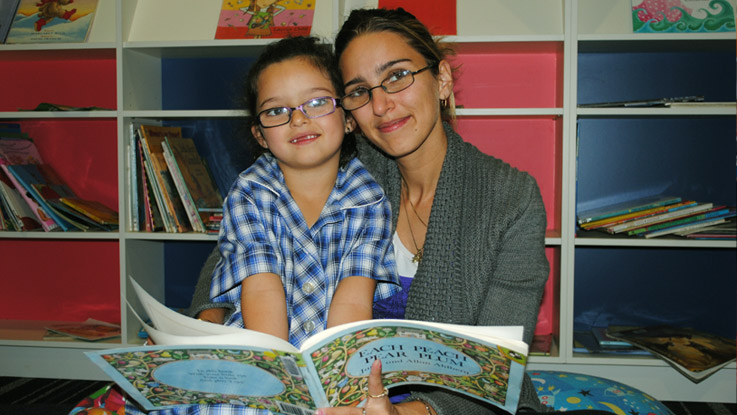
New research report offers solution to closing the educational gap for disadvantaged students
A national program, providing highly-disadvantaged children targeted education assistance throughout their schooling, is having a significantly positive impact on their educational outcomes a landmark research report by The Smith Family concludes.
The report highlights the success of The Smith Family’s national scholarship program, Learning for Life, and finds that seven out of ten students on the program are completing Year 12, a result that will boost their employment and social participation outcomes.
The Smith Family’s Head of Research and Advocacy, Anne Hampshire, said this compared favourably with six out of ten young Australians from the lowest socioeconomic backgrounds nationally completing Year 12 or its equivalent.
The report, Improving the educational outcomes of disadvantaged young Australians: The Learning for Life program, released today demonstrates the effectiveness of the groundbreaking educational program, which assists about 34,000 students and their families a year in 94 communities.
“Despite significant investment in a range of initiatives over the years – by governments, non-government and philanthropic organisations – too many young Australians are still not achieving educationally,” Ms Hampshire said.
“The potential consequences are a lifetime of disadvantage and its associated impacts, including welfare dependency and social isolation.
“However, the data we’ve gathered over the last four years is demonstrating our approach – intervening early and providing long-term educational support for very disadvantaged young people – is working.
“This is underpinning a new level of confidence and optimism for us, as the results confirm that Learning for Life is one solution to Australia’s longstanding educational problem.”
Learning for Life can start in the first year of school and run through to the completion of tertiary education. It provides a range of short programs including literacy and numeracy, learning clubs, mentoring and career activities, as well as digital and financial literacy initiatives for parents.
Since 2012, The Smith Family’s support has enabled over 6,500 disadvantaged young Australians to finish Year 12.
Significantly, between 2012 and 2015, The Smith Family has increased the number of scholarship students completing Year 12 by 22 percent.
In 2015, more than four-in-five (84 percent) former Learning for Life students who left the program in Years 10, 11 or 12, were engaged in employment, education or training, a year after leaving the program.
Ms Hampshire said educational attainment was an important predictor of a person’s future employment, income, health and welfare prospects.
“Our research is showing that our highly targeted Learning for Life program is having a very encouraging beneficial impact,” Ms Hampshire said. “The program has been tested at scale and importantly, it’s also cost-effective, at around just $1,000 per student per annum.
“It is delivering outcomes beneficial to the long-term economic and social wellbeing of young people and for national productivity and social cohesion.”
Students on the program are highly disadvantaged and face the following challenges:
- All are living in low income families.
- About 6,000 are of Aboriginal and Torres Strait Islander background.
- 40 percent of students and 50 percent of parents/carers have a health or disability issue.
- Over half live in a single parent family.
- Over 70 percent have a parent/carer who is not in paid employment.
- One in five students in Years 5 to 12 has attended four or more schools and one in 20 has been at six or more.
“Learning for Life students are also more disadvantaged than their school peers, even though the schools they attend are classified as disadvantaged,” Ms Hampshire said.
“National and international data shows that Australia’s educational performance is either stagnating or declining overall, with significantly poorer results for students from disadvantaged backgrounds.
“The problem starts early with gaps in educational achievement, based on students’ background, apparent in the first year of school. These gaps grow as young people move through school, resulting in two in every five young adults from disadvantaged backgrounds not transitioning to employment or further study.
“In the context of Australia’s ongoing debate about educational performance, it’s essential that we find scalable and cost-effective solutions that improve the educational attainment of disadvantaged children.
“Not addressing this issue ultimately compromises Australia’s national economic and social participation ambitions.
“Learning for Life is not the only answer to Australia’s educational challenge – but it is certainly making an important contribution. With further support – including from governments, business, philanthropy and individual Australians – it could be expanded easily, enabling the kind of lasting change and positive outcomes we all want for our children and our nation.”
Download full report [pdf 1.25MB]
Media contacts:
Andrew Dickson | National Media Manager (National) - 0421 285 529 | andrew.dickson@thesmithfamily.com.au
Carla Horton | Senior Media Advisor (QLD & WA) - 0423 618 776 | carla.horton@thesmithfamily.com.au
Reid Jermyn | Media Advisor (VIC, SA & NT) - 0412 803 566 | reid.jermyn@thesmithfamily.com.au
Ben Chenoweth | Senior Media Advisor (NSW, ACT & TAS) - 0413 346 934 | ben.chenoweth@thesmithfamily.com.au
The Smith Family is a national children’s education charity that helps young Australians experiencing disadvantage to create better futures for themselves through harnessing the power of education. We partner with around 800 Australian schools and work with over 162,000 children and young people experiencing disadvantage access our education support programs to help them overcome . For more information, visit thesmithfamily.com.au
